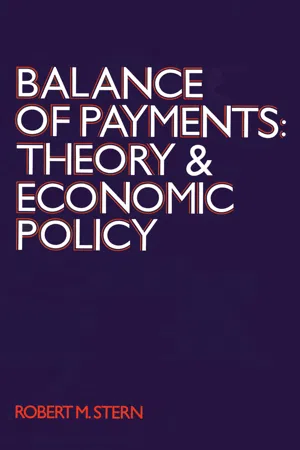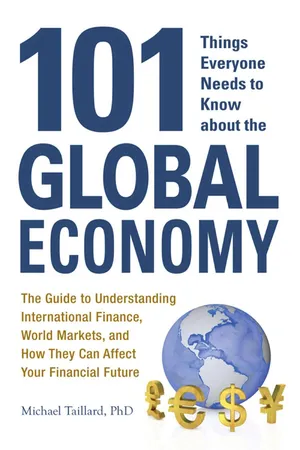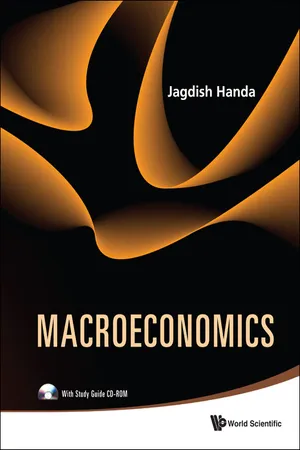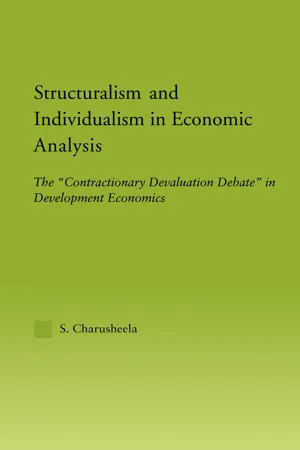Economics
Balance of Payments
The balance of payments is a record of all economic transactions between a country and the rest of the world over a specific period. It consists of the current account, which includes trade in goods and services, and the capital account, which tracks financial transactions. A surplus or deficit in the balance of payments can indicate a country's economic strength or vulnerability.
Written by Perlego with AI-assistance
Related key terms
7 Key excerpts on "Balance of Payments"
- eBook - ePub
Balance of Payments
Theory and Economic Policy
- Robert Stern(Author)
- 2017(Publication Date)
- Routledge(Publisher)
1 Balance-of-Payments Concepts and MeasurementOur concern in the present chapter is the arrangement and interpretation of balance-of-payments information for purposes of economic analysis and policy assessment. Balance-of-payments accounting is illustrated briefly in the appendix to this chapter. Those interested in greater detail, especially on matters related to accounting, are advised to consult specialized sources.1Balance-of-Payments Concepts
It is appropriate to begin by a definition : the balance ofpayments is a summary statement of all economic transactions between the residents of one country and the rest of the world, covering some given period of time.Like many definitions, this one requires clarification, especially with respect to the coverage and valuation of economic transactions and the criteria for determining residency. The coverage of economic transactions refers to both commercial trade dealings and noncommercial transfers, which may or may not be effected through the foreign exchange markets and which may not be satisfactorily recorded because of inadequacies in the system of data collection. Particularly difficult questions of valuation are posed by noncommercial transactions and by transactions that take place between domestic and foreign-based units of individual corporations. The determination of residency should ordinarily not be difficult, but even here questions may arise concerning the treatment of overseas military forces and embassies, corporate subsidiaries, and international organizations.2Transactions are recorded in principle on a double-entry bookkeeping basis. Each transaction entered in the accounts as a credit must have a corresponding debit and vice versa. The distributions commonly made in classifying the various accounts can be seen from the schematic Balance of Payments represented in Table 1.1 and from the illustrative transactions recorded in the appendix to this chapter. There are many possible interrelationships among the various items shown in Table 1.1 that arise from the complexities of the market and nonmarket transactions typically recorded for an individual nation. Thus, the receipts and payments arising from merchandise and service exports and imports shown in the current account may have their counterpart debits or credits recorded in one or more of the remaining accounts.3 - eBook - ePub
- W. Charles Sawyer, Richard L. Sprinkle(Authors)
- 2020(Publication Date)
- Routledge(Publisher)
balance on capital account. The balance on current account is a record of transactions that includes payments for goods, services, and other items described below. The balance on financial account is a record of transactions that includes payments related to financial assets such as bonds. It also includes transactions involving the sale or acquisition of foreign nonfinancial assets like land. The balance on capital account is a record of other activities resulting in transfers of wealth between countries. This includes nonmarket international asset transfers including debt forgiveness and the transfer of bank accounts by foreign citizens when immigrating to the U.S.At the most basic level, the Balance of Payments is a record of all economic transactions derived from the exchange of goods, services, income, and assets between residents of one country and the rest of the world. The Balance of Payments accounts record the total inflows and outflows of money to and from foreign countries. The inflows and outflows are relatively large for the U.S. Indeed, tracking every dollar would be impossible. One needs to keep in mind that the Balance of Payments statistics for the U.S. or any country are a rough approximation of the magnitude of these flows rather than a precise number resulting from a precise accounting system. Although we are using the term accounting in association with the Balance of Payments account record, in this context the term means something very different from that accountants use. As a result, our first objective is to describe the terminology in the Balance of Payments statement. Our second objective is to ascertain what a country’s Balance of Payments accounts tell us about the country’s domestic economy. As we will show, one can learn a lot about a country’s economy from analyzing its Balance of Payments statement.
Table 13.4The balance on current account - eBook - ePub
- Daniel R. Kane(Author)
- 2018(Publication Date)
- Routledge(Publisher)
flowed into and out of a country over a specified period, usually twelve months. Although Balance of Payments measures are compiled and published on a quarterly and even monthly basis, short-term fluctuations mean that these are only a general guide to overall trends. Even annual payments measures, because of data deficiencies and inaccuracies, have to be revised, sometimes over several years and sometimes significantly in both size and scope.APPLICATIONAt a microeconomic level, Balance of Payments measures are used to: analyse the economic role of individual goods and services accounts; quantify variations in the magnitude and direction of capital flows; identify the sources and uses of foreign exchange.These microeconomic applications describe individual international activities whose economic impact might be counterbalanced by activities recorded elsewhere in the Balance of Payments.At a macroeconomic level, Balance of Payments measures relate to aggregate international activities and indicate whether an economy is in external equilibrium or whether the foreign sector is subjecting the domestic economy to expansionary or contractionary pressures (external disequilibrium). This enables Balance of Payments measures to be used as a basis for either restoring external equilibrium or using external disequilibrium as a macroeconomic policy variable to achieve, for example, domestic economic expansion.The application and interpretation of Balance of Payments measures is subject to two qualifications:Firstly, Balance of Payments measures include both final and intermediate goods and services. They are not therefore a direct indicator of economic welfare.Secondly, imbalances in Balance of Payments measures reflect surpluses and deficits and not profits and losses. This is because Balance of Payments measures record the flow of goods, services and capital into and out of a country and not the terms - eBook - ePub
101 Things Everyone Needs to Know about the Global Economy
The Guide to Understanding International Finance, World Markets, and How They Can Affect Your Financial Future
- Michael Taillard(Author)
- 2012(Publication Date)
- Adams Media(Publisher)
CHAPTER 3 Balance of PaymentsExports leave one country and imports enter another country; ownership of capital assets is exchanged time and again across the globe. All of this happens in varying quantities and prices, and for each nation it is recorded and added up in a huge record called the Balance of Payments.The Balance of Payments, often referred to as the BoP, is a detailed accounting of the value of all international transactions for a country. It is broken down into three primary elements: the current account , the capital account , and the transfer payments account . The transactions relevant to each account are then further classified according to the type of goods or services being exchanged.- The current account includes all imports and exports of goods and services. Within the current account are such categories as manufactured and assembled goods, and services.
- The capital account includes all transfers of capital ownership. Within the capital account are reserve assets, foreign direct investment, and any other form of ownership stake that a foreign nation might hold in another country’s economic well-being.
- The transfer payments account deals with those transactions in which goods or capital are given freely to others without compensation. This account is sometimes referred to as the balancing account.
The primary principle of the Balance of Payments is that it must always (as the name implies) balance. This happens through a process similar to double-entry accounting: Each international transaction influences the value of two BoP accounts for each nation. Any time one of the accounts in the Balance of Payments changes value, a different account changes in value by the same amount but in the opposite direction. For example, if the current account increases by $35 million, then one of the two remaining accounts (capital or transfer payments) must decrease by $35 million.On a smaller scale, of course, this happens in any transaction. For instance, when you buy a $35 bottle of gin, you receive the gin bottle in what would be a current account transaction. You now possess a bottle of gin that increases by $35 your net worth in goods. You give the store owner $35 in cash, a capital account transaction (you’re effectively transferring some of your capital to the liquor store owner) that decreases your available capital by $35. If, by some miracle, the store owner decides to simply give you the gin, then the transaction represents a decrease in the transfer payments account and an increase in your current account, thus balancing the BoP (this is the reason the transfer payments account is sometimes called the balancing account). - eBook - ePub
The Chase Across The Globe
International Accumulation And The Contradictions For Nation States
- Dick Bryan(Author)
- 2019(Publication Date)
- Routledge(Publisher)
Chapter 9 shows how the post-war evolution of economic theory and policies with respect to the Balance of Payments has moved increasingly towards targeting labor as the key to 'national success'.The System of Accounting
The Balance of Payments measures the movement of capital (commodities and money) between countries. It comprises two accounts: the current account, measuring inflows and outflows of commodities and income over an accounting period; and a capital account, measuring changes in international asset holdings over an accounting period. Hence the current account measures flows, in which all transactions, inward and outward, are shown, and the capital account measures stocks (for example, the level of direct foreign investment) for which only a net figure is shown (investment by foreigners less withdrawal of investment by foreigners).The system of double entry book-keeping ensures that the Balance of Payments always balances. Even when the exchange rate does not move to balance the current account, a surplus or deficit in the current account has a counter-entry in the capital account, showing respectively as a build-up of foreign reserves, or as increasing foreign debt. This accounting process has created the impression that the capital account 'compensates' for imbalances in the current account; although whether this describes a real process, or just an accounting construction, is a recognised debate which will be considered shortly. - eBook - ePub
Macroeconomics
(With Study Guide CD-ROM)
- Jagdish Handa(Author)
- 2010(Publication Date)
- WSPC(Publisher)
Hence, in well-developed financial markets, IRP provides the short-term determination of the exchange rates while PPP or its relative version at best only provides a long-term tendency, so that exchange rates determined through IRP can deviate from PPP for considerable periods. 3.6 The Balance of Payments The Balance of Payments can be defined or presented in an economic or accounting form. Economic analysis focuses mainly on its economic form. The (economic) Balance of Payments is a statement of the inflows and the outflows of funds from the domestic country and the difference between them. If the economic Balance of Payments were arranged in the form of a table, it would specify each of the sources of the inflows and outflows of funds from a country, and the difference between them. This is illustrated in Table 3.1. The inflows of foreign exchange during a period are the sum of the payments we receive for commodities and financial assets sold to foreigners plus interest and dividends on our investments abroad and unilateral transfers (such as gifts) from foreigners. The outflows of foreign exchange are the sum of the payments we make for commodities and financial assets bought from foreigners plus interest and dividends on foreign investments in our country and unilateral transfers (such as gifts) to foreigners - S. Charusheela(Author)
- 2013(Publication Date)
- Routledge(Publisher)
The table below provides a sample Balance of Payments (BOP). The BOP is an account which tracks the flows of income, expenditures, and capital across national borders. It represents the aggregate economic transactions undertaken by the members of a nation and the rest of the world. The entries on the Left hand side represent economic activities that generate foreign exchange, and the entries on the Right hand side represent economic activities that use foreign exchange.
NOTES a) All items on the Left Hand Side are POSITIVE or inflows, while all items on the Right Hand Side are outflows and so have to be DEDUCTED from the BOP when the account balances. b) The balance between the items in 1, Exports less Imports, is called the trade balance. c) The balance between the inflows and outflows on the current account (items 1-4) is called the current account balance.Sources of Foreign Exchange Uses of Foreign Exchange “Balances” Current Account Trade 1.Exports Imports Balance 2.Income received on factor services Income paid for factor services (including interest on past debt) Current 3.Private Remittances from Abroad Remittances to foreign residents Account 4.Unilateral Receipts (Official) Capital Account Unilateral Disbursements (Official) Balance Captial Account 5.Direct Foreign investment from abroad DFI undertaken abroad 6.Long Term foreign Borrowing Long Term Foreign Lending Global 7.Short Term Foreign Borrowing Short Term Foreign Lending Balance Official Settlements 8.Reductions in Reserves Sales of Gold Sales of Foreign Exchange Sales of Other Assets by Central Bank Additions to Reserves Purchases of Gold Purchases of Foreign Exchange Purchases of Other Assets by Central Bank (where this line should be is disputed in policy debates) d) The items on the Left Hand Side in the capital account are capital imports and represent an inflow of foreign exchange. The items on the Right Hand Side are capital exports and reflect a use of foreign exchange. One could, if one wished, present net flows of capital: Net inflows (or imports of capital) would be added, Net outflows (or export of capital) would be subtracted.
Learn about this page
Index pages curate the most relevant extracts from our library of academic textbooks. They’ve been created using an in-house natural language model (NLM), each adding context and meaning to key research topics.






